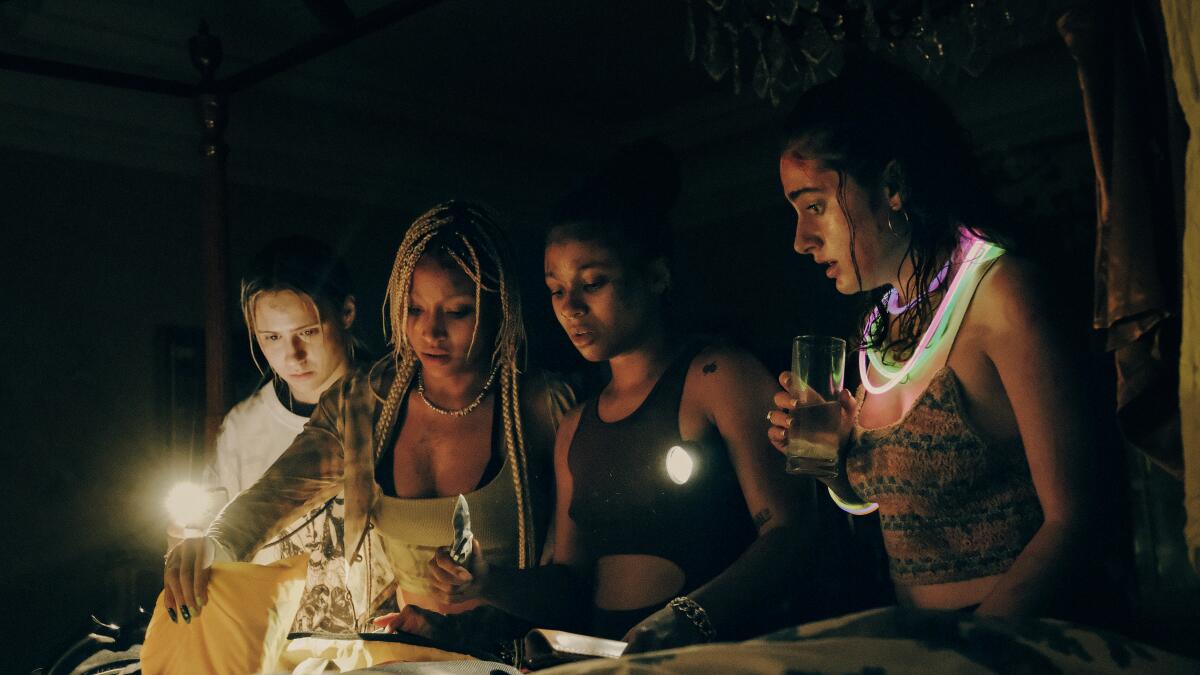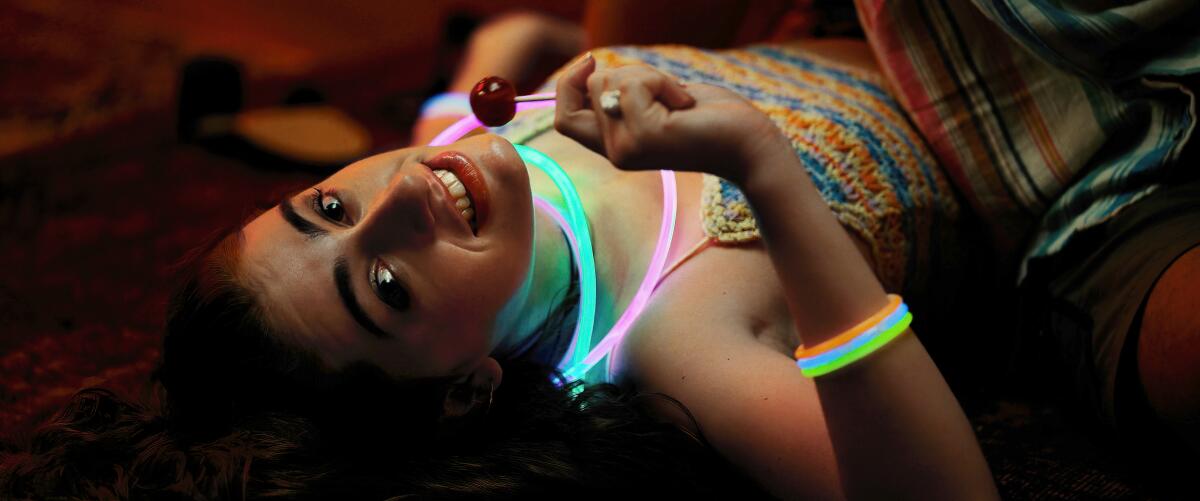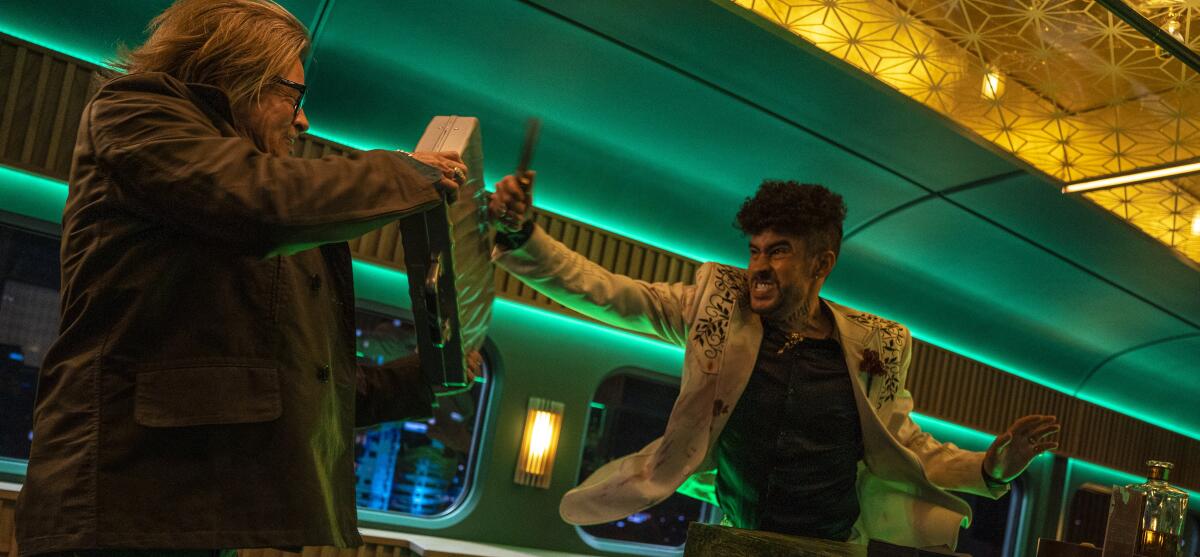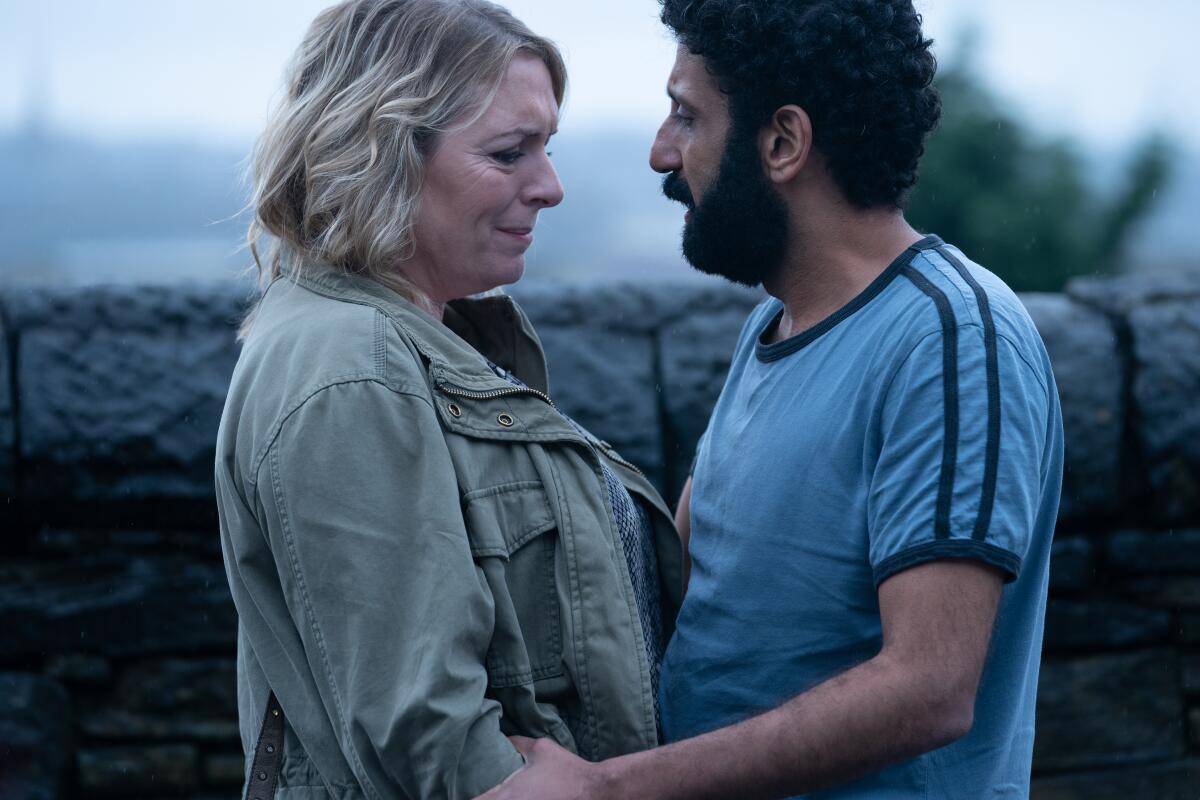How the young cast of ‘Bodies Bodies Bodies’ poke fun at themselves

- Share via
Hello! I’m Mark Olsen. Welcome to another edition of your regular field guide to a world of Only Good Movies.
Only good movies
Get the Indie Focus newsletter, Mark Olsen's weekly guide to the world of cinema.
You may occasionally receive promotional content from the Los Angeles Times.
”Alma’s Rainbow,” newly restored. The American Cinematheque is screening the new restoration of Ayoka Chenzira’s 1994 film, “Alma’s Rainbow,” along with Chenzira’s 1984 short, “Hair Piece: A Film for Nappyheaded People.” “Rainbow,” a recovered gem of ’90s Black independent filmmaking (and a glimpse at very ’90s fashion and aesthetics), is a coming-of-age dramedy about three young women living in Brooklyn and trying to figure out what to do next with their lives. For RogerEbert.com, Marya E. Gates interviewed Chenzira, and her reminiscences on childhood and her inspirations are good reading.
Agnès Godard tribute. The UCLA Film and Television Archive is kicking off a program titled “This Woman’s Work: Cinematographer Agnès Godard” that will run through 14. The series begins with Claire Denis’ “Beau Travail” and Agnès Varda’s “Jacquot de Nantes.” Other films include Denis’ “Nénette and Boni” and “35 Shots of Rum,” along with Erick Zonca’s “The Dreamlife of Angels” and Ursula Meier’s “Sister.” This is a rare chance to see many of these films in a theater.
Garrel’s “Guitar.” The Mezzanine series continues to be a vital addition to the film scene in Los Angeles. On Thursday, the series will feature Philippe Garrel’s 1991 film, “I Can No Longer Hear the Guitar,” in 35mm at Brain Dead Studios on Fairfax Avenue. Garrel — known to some as the father to actors Louis and Esther — remains perpetually underrated as a filmmaker, creating deeply personal works that are intimate in their storytelling but epic in their emotions. “Guitar” is a fictionalization of his long affair with the musician Nico.
Enjoying this newsletter? Consider subscribing to the Los Angeles Times
Your support helps us deliver the news that matters most. Become a subscriber.
‘Bodies Bodies Bodies’
Directed by Halina Reijn from a screenplay by playwright Sarah DeLappe, “Bodies Bodies Bodies” is a summer slasher film that is also a satire of contemporary youth culture. A group of friends (and a few strangers) get together at a remote mansion to party hard as a storm approaches. When they begin to die violent deaths one by one, they quickly turn on one another. The cast includes Amandla Stenberg, Pete Davidson, Maria Bakalova, Rachel Sennott, Myha’la Herrold, Chase Sui Wonders and Lee Pace. The movie is in theaters now.
For The Times, Justin Chang wrote, “It’s kind of funny and kind of scary, if ultimately neither funny nor scary enough to keep the two modes from canceling each other out. The director Halina Reijn … is trying to pull off something appreciably ambitious here: the nihilistic crowd-pleaser, the cynically tossed-off generational statement, the evisceration of insufferably vapid characters that somehow avoids tilting into its own insufferable vapidity. She’s also bent on making a smart, crafty genre picture that will keep you guessing, laughing and screaming simultaneously — and this, too, proves its own devilishly tricky proposition.”
I wrote about how “Bodies Bodies Bodies” — along with Lena Dunham’s “Sharp Stick” and Quinn Shephard’s “Not Okay” — tries to capture the sensibilities of Gen Z. As Stenberg said, “We get asked a lot on this press tour for ‘Bodies’ if we spend less time on our phones after working on this film. And that’s really not what it’s about, because the phones are here. They’re not going anywhere.”
For the AP, Lindsey Bahr wrote, “‘Bodies Bodies Bodies’ might just be the first great Gen Z thriller. In director Halina Reijn’s film is a razor-sharp satire of a very specific kind of modern privilege set inside an escalating murder mystery in a remote mansion as a hurricane rages outside. … And yet even as things devolve and more friends are murdered, the dwindling surviving characters try their best to avoid microaggressions and triggering words as though navigating a fight on Twitter.”
For IndieWire, Robert Daniels wrote, “It all comes together, primarily, because Reijin crafts a convincing mirror against super-online audiences. Her direction imbues this film with a striking originality, wherein the unrelenting tension and paranoid mood combine toward unnerving ends. … Whether any of this ages well is anybody’s guess, and probably secondary to the point of this very present film. But it’s the uproarious image of rich kids without wifi, descending into frothing at the mouth, bloody madness, that makes Reijin’s ‘Bodies Bodies Bodies’ an unmistakable Gen Z anthem for blood.”
For Deadline, Valerie Complex wrote, “Spoiled rich brats who have been trauma bonding for too long have to witness their bestie circle tumble like a house of cards. That’s the real horror behind DeLappe’s screenplay, not the blood and guts. While the narrative and plotting aren’t always tight, ‘Bodies Bodies Bodies’ serves as more of a warning on what can happen when you’re not honest about the company you keep and what happens when everyone in your friend group is toxic, including yourself.”

Enjoying this newsletter? Consider subscribing to the Los Angeles Times
Your support helps us deliver the news that matters most. Become a subscriber.
‘Bullet Train’
Directed by David Leitch from a screenplay by Zak Olkewicz adapted from a novel by Kotaro Isaka, “Bullet Train” aims to be a summery and fun popcorn thrill ride. (Whether it pulls into that station, though ... see below.) Brad Pitt plays an assassin known as Ladybug who has been looking to get out of the game and takes a job, to retrieve a suitcase, that he thinks will be low-impact. He‘s wrong. With a cast that also includes Brian Tyree Henry, Aaron Taylor-Johnson, Benito Antonio Martínez Ocasio (a.k.a Bad Bunny), Joey King, Zazie Beetz, Sandra Bullock and many more, the movie is in theaters now.
For the New York Times, Manohla Dargis is always a must-read when it comes to big, loud action movies. As she wrote, “The giddily violent bummer ‘Bullet Train’ takes place in Japan on a high-speed train that turns into a theater of death. It’s watchable — it stars Brad Pitt — jokey, sometimes funny and predictably stupid. Hollywood has long churned out dumb, brutal stories, one difference being that today filmmakers no longer need to rationalize carnage with moralizing or blather about heroic codes. … The hero of ‘John Wick’ is on a mission; Ladybug is on a job. In other words, ‘John Wick,’ in classic American (cinematic) fashion, presents a moral justification for its slaughter. ‘Bullet Train’ doesn’t even bother serving up such self-elevating, audience-flattering fantasies — its blood lust is honest.”
For Vulture, Bilge Ebiri wrote, “‘Bullet Train’ feels like someone crossbred ‘Kill Bill’ with a ‘Final Destination’ movie. And at times, David Leitch’s film is almost as glorious as that description makes it sound — elaborate and ridiculous but dedicated to making the elaborate and the ridiculous feel … well, not plausible, exactly, but certainly compelling and fun. Not to mention the film’s conviction that there is no level of baroque narrative digression a modern audience will not tolerate. I took something like 50 pages of notes, and I still feel like I caught about half of what happened.”
For Rolling Stone, David Fear wrote, “It takes a certain type of actor to transcend mediocre-to-massively-disappointing material. It takes a truly rare movie star to not only rise above a mess, however, but convince you that his or her mere presence is what’s keeping it from turning into a complete trainwreck. The amount of casual charisma and commitment Pitt is bringing to this is the one thing that actually differentiates this from being just another stylishly lit, stupid-hip snarkfest. … The sheer pleasure of watching him do what he does best comes close to balancing out you suffering through everything else.”
For Slate, Dana Stevens wrote, “On a hot August afternoon in the middle of a movie year when the future of film as an art and a business has never felt more uncertain, a part of me resents having to sit down and write about a movie like ‘Bullet Train.’ … At a moment in his career when Pitt seems to be contemplating how to transition to a third act, it is to be hoped he will consider a different means of transportation next time.”

‘Ali & Ava’
Written and directed by Clio Barnard, “Ali & Ava” is another of the English filmmaker’s explorations of the lives of people who rarely make it to the screen. Ali (Adeel Akhtar), recently separated and moonlighting as a DJ, and Ava (Claire Rushbrook), a widowed schoolteacher, meet and begin a tentative romance, two lonely people bonding in part over their shared love of music. The movie is now in limited release.
For The Times, Justin Chang wrote, “You might be swept slightly off-balance by this movie, which is a fair approximation of how Ali and Ava feel most of the time. Their good-humored tenacity is a natural response to years of heartache and hardship, which they’ve spent serving as the emotional glue to their large, fractious extended families. … Barnard has made an ode to the beauty of messy, imperfect lives and their ability to converge at improbably perfect moments. Maybe it ends a beat too soon, but then so do some of your favorite songs.”
For RogerEbert.com, Glenn Kenny wrote, “This is a gentle unassuming film about gentle unassuming people. It’s possible that many viewers might find it too gentle. Barnard isn’t nearly as interested in narrative momentum as she is in just letting the viewer sit with these people. Not just to enjoy their company, such as it is, but to contemplate the vicissitudes of life and love in this particular working-class environment, an environment in which isolation is, for better or worse, virtually impossible. … In its understated way, the movie is a celebration of the miracle of connection. Ava and Ali initially communicate through musical modes, but these signals reveal a deeper need: two warm hearts that need a place to share that warmth.”
For the New York Times, Beandrea July wrote, “The onscreen chemistry between them feels forced and flat, and the decidedly tame portrayals of physical intimacy only accentuate this absence. The tension that Ali and Ava’s interracial relationship surfaces within Ava’s family and white neighborhood is barely reckoned with in the film, and the result is an unconvincing racial reconciliation fairy tale in an embattled factory town in Yorkshire.”

Only good movies
Get the Indie Focus newsletter, Mark Olsen's weekly guide to the world of cinema.
You may occasionally receive promotional content from the Los Angeles Times.




